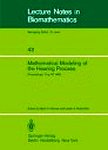版权所有:内蒙古大学图书馆 技术提供:维普资讯• 智图
内蒙古自治区呼和浩特市赛罕区大学西街235号 邮编: 010021

丛 书 名:Lecture Notes in Biomathematics
版本说明:1
I S B N:(纸本) 9783540111559
出 版 社:Springer Berlin Heidelberg
出 版 年:1000年
页 数:VI, 108页
主 题 词:Mathematical Modeling and Industrial Mathematics Neurosciences Mathematical and Computational Biology
摘 要:The articles of these proceedings arise from a NSF-CBMS regional conference on the mathematical modeling of the hearing process, that was held at Rensselaer Polytechnic Institute in the summer of 1980. To put the a=ticles in perspective, it is best to briefly review the history of suc~ modeling. It has proceeded, more or less, in three stages. The first was initiated by Herman Helmholtz in the 1880 s, whose theories dominated the subject for years. However, because of his lack of accurate experimental data and his heuristic arguments it became apparent that his models needed revision. Accordingly, based on the experimental observations of von Bekesy, the long wave theories were developed in the 1950 s by investigators such as Zwislocki, Peterson, and Bogert. However, as the ex?eri~ents became more refined (such as Rhode s ~wssbauer Measurements) even these models came into question. This has brought on a flurry of activity in recent years into how to extend the models to account for these more recent eXT. lerimental observations. One approach is through a device co~monly refered to as a second filter (see Allen s article) and another is through a more elaborate hydroelastic model (see Chadwick s article). In conjunction with this latter approach, there has been some recent work on developing a low frequency model of the cochlea (see Holmes article).